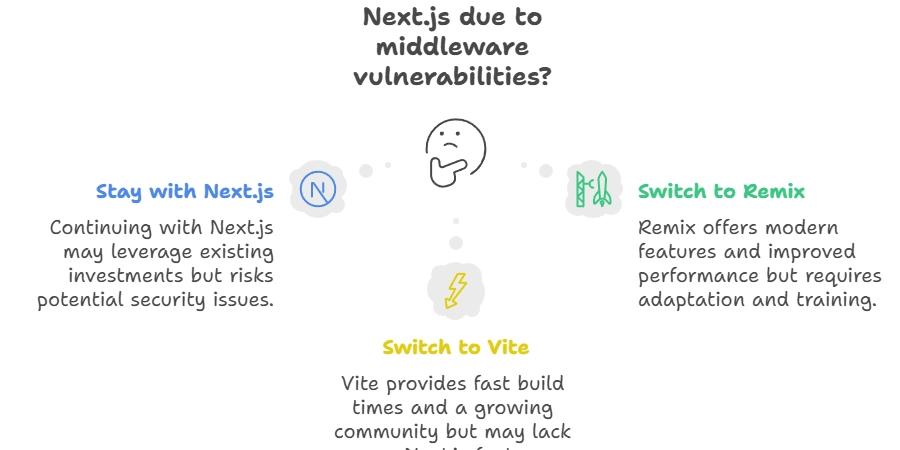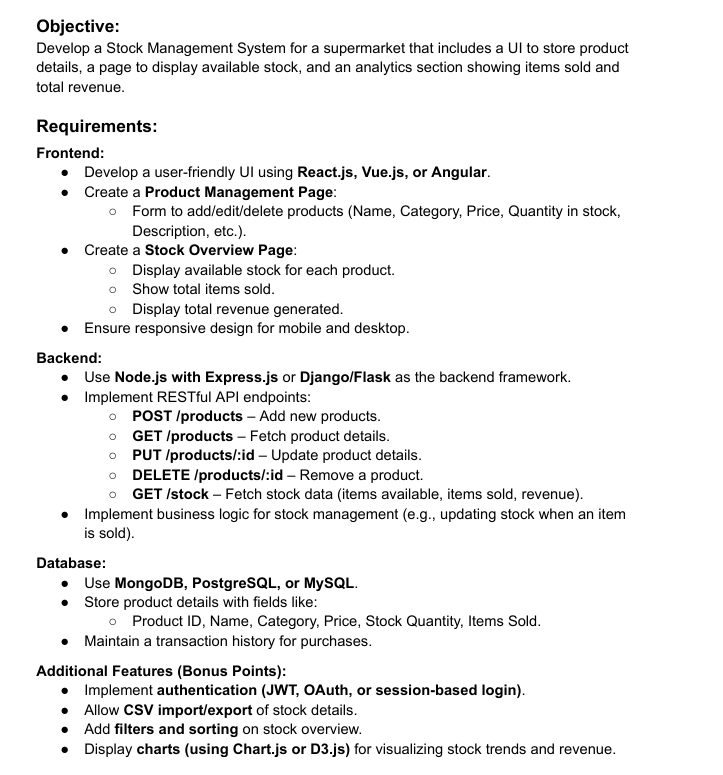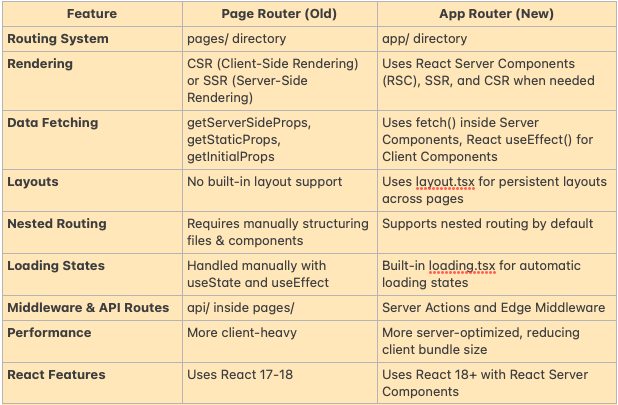Next.js Middleware: A Critical Examination for Strategic Leaders
In the rapidly evolving digital landscape, even industry-leading frameworks can present unforeseen challenges. Recent developments around Next.js particularly its middleware vulnerabilities have ignited a debate among top-tier decision-makers regarding the framework's long-term viability. This newsletter dives into the nuanced technical and operational issues impacting Next.js deployments, and examines whether enterprises should start considering alternatives like Remix or Vite. 1. The Core Vulnerability and Its Implications CVE-2025–29927 and the Auth Bypass A critical flaw (CVE-2025–29927) in Next.js 15 has been identified that allows attackers to bypass middleware authentication controls by injecting a specially crafted x-middleware-subrequest header. This vulnerability effectively negates key security checks, potentially granting unauthorized access to sensitive administrative endpoints. The breach highlights a broader issue: reliance on middleware for security without layered safeguards can expose enterprise applications to significant risk. As detailed by Help Net Security, while patches have been rapidly deployed by Vercel, the widespread use of Next.js across major platforms (Twitch, Spotify, Binance, among others) means that even a transient window of exposure could have high-stakes consequences. Operational Disruptions Beyond Security While the security bypass is the most alarming facet, Next.js also faces persistent operational challenges: Hydration Errors: These client-side issues affect how dynamic content is rendered, leading to performance inconsistencies and a degraded user experience. Server Compatibility: Despite its promise of universal deployment, many features of Next.js are optimized for the Vercel environment. Deployments on alternative infrastructures like AWS often encounter configuration difficulties and reliability concerns. These technical hurdles suggest that Next.js might not be the "one-size-fits-all" solution it was once thought to be, particularly when rigorous enterprise-grade performance is required. 2. Real-World Impact and Market Reactions Case Studies and Industry Feedback The vulnerabilities and operational issues are not merely theoretical. Enterprises have reported: Security Incidents: Instances where misconfigurations allowed unauthorized access, triggering costly investigations and remediation efforts. Deployment Challenges: Firms attempting to integrate Next.js on cloud platforms other than Vercel have experienced significant delays, leading to project overruns and strained developer resources. Shifting Paradigms: From Next.js to Remix or Vite? The challenges faced by Next.js have spurred discussion among CTOs and development leads regarding the viability of alternative frameworks: Remix: With its emphasis on robust data handling and streamlined server-side rendering, Remix is gaining traction among enterprises seeking better reliability and performance. Vite: Known for its fast build times and lean architecture, Vite appeals to organizations looking for cutting-edge development experiences without the operational overhead encountered in Next.js. Recent industry surveys and anecdotal evidence from leading tech firms indicate a gradual but notable shift toward these alternatives. For instance, several high-profile companies have already initiated pilots with Remix, citing its flexible routing and error handling as critical advantages in an era where user experience and security are paramount. 3. Strategic Considerations for C-Suite Leaders Risk Management and Mitigation For companies relying on Next.js, the immediate priority should be to ensure that all production environments are patched and that additional protective measures (e.g., custom firewall rules to block malicious headers) are implemented. However, this reactive approach may not suffice in the long term. Diversification of Technology Stack: Investing in alternative frameworks can mitigate the risk of being locked into a platform with recurring vulnerabilities. Robust QA and Deployment Practices: Enterprises must intensify their quality assurance practices to catch subtle issues like hydration errors before they impact end-users, especially when deploying in non-native environments such as AWS. Long-Term IT Roadmaps While Next.js continues to be a popular choice owing largely to its association with Vercel the underlying issues demand that executives revisit their technology roadmaps. Transitioning to frameworks like Remix or Vite not only addresses current operational pain points but also positions companies for future agility in an increasingly competitive digital arena. Conclusion The Next.js middleware issue is a wake-up call for enterprise technology leaders. The critical security vulnerability, compounded by operational challenges such as hydration

In the rapidly evolving digital landscape, even industry-leading frameworks can present unforeseen challenges. Recent developments around Next.js particularly its middleware vulnerabilities have ignited a debate among top-tier decision-makers regarding the framework's long-term viability. This newsletter dives into the nuanced technical and operational issues impacting Next.js deployments, and examines whether enterprises should start considering alternatives like Remix or Vite.
1. The Core Vulnerability and Its Implications
CVE-2025–29927 and the Auth Bypass
A critical flaw (CVE-2025–29927) in Next.js 15 has been identified that allows attackers to bypass middleware authentication controls by injecting a specially crafted x-middleware-subrequest header. This vulnerability effectively negates key security checks, potentially granting unauthorized access to sensitive administrative endpoints.
The breach highlights a broader issue: reliance on middleware for security without layered safeguards can expose enterprise applications to significant risk. As detailed by Help Net Security, while patches have been rapidly deployed by Vercel, the widespread use of Next.js across major platforms (Twitch, Spotify, Binance, among others) means that even a transient window of exposure could have high-stakes consequences.
Operational Disruptions Beyond Security
While the security bypass is the most alarming facet, Next.js also faces persistent operational challenges:
- Hydration Errors: These client-side issues affect how dynamic content is rendered, leading to performance inconsistencies and a degraded user experience.
- Server Compatibility: Despite its promise of universal deployment, many features of Next.js are optimized for the Vercel environment. Deployments on alternative infrastructures like AWS often encounter configuration difficulties and reliability concerns.
These technical hurdles suggest that Next.js might not be the "one-size-fits-all" solution it was once thought to be, particularly when rigorous enterprise-grade performance is required.
2. Real-World Impact and Market Reactions
Case Studies and Industry Feedback
The vulnerabilities and operational issues are not merely theoretical. Enterprises have reported:
- Security Incidents: Instances where misconfigurations allowed unauthorized access, triggering costly investigations and remediation efforts.
- Deployment Challenges: Firms attempting to integrate Next.js on cloud platforms other than Vercel have experienced significant delays, leading to project overruns and strained developer resources.
Shifting Paradigms: From Next.js to Remix or Vite?
The challenges faced by Next.js have spurred discussion among CTOs and development leads regarding the viability of alternative frameworks:
- Remix: With its emphasis on robust data handling and streamlined server-side rendering, Remix is gaining traction among enterprises seeking better reliability and performance.
- Vite: Known for its fast build times and lean architecture, Vite appeals to organizations looking for cutting-edge development experiences without the operational overhead encountered in Next.js.
Recent industry surveys and anecdotal evidence from leading tech firms indicate a gradual but notable shift toward these alternatives. For instance, several high-profile companies have already initiated pilots with Remix, citing its flexible routing and error handling as critical advantages in an era where user experience and security are paramount.
3. Strategic Considerations for C-Suite Leaders
Risk Management and Mitigation
For companies relying on Next.js, the immediate priority should be to ensure that all production environments are patched and that additional protective measures (e.g., custom firewall rules to block malicious headers) are implemented. However, this reactive approach may not suffice in the long term.
- Diversification of Technology Stack: Investing in alternative frameworks can mitigate the risk of being locked into a platform with recurring vulnerabilities.
- Robust QA and Deployment Practices: Enterprises must intensify their quality assurance practices to catch subtle issues like hydration errors before they impact end-users, especially when deploying in non-native environments such as AWS.
Long-Term IT Roadmaps
While Next.js continues to be a popular choice owing largely to its association with Vercel the underlying issues demand that executives revisit their technology roadmaps. Transitioning to frameworks like Remix or Vite not only addresses current operational pain points but also positions companies for future agility in an increasingly competitive digital arena.
Conclusion
The Next.js middleware issue is a wake-up call for enterprise technology leaders. The critical security vulnerability, compounded by operational challenges such as hydration errors and deployment restrictions, underscores the need for a strategic reassessment of web application frameworks.
Decision-makers must weigh the immediate costs of patching and protecting current deployments against the long-term benefits of transitioning to more robust alternatives like Remix or Vite. By proactively managing these risks, companies can safeguard their digital assets and maintain a competitive edge in a rapidly changing technological landscape.















































































